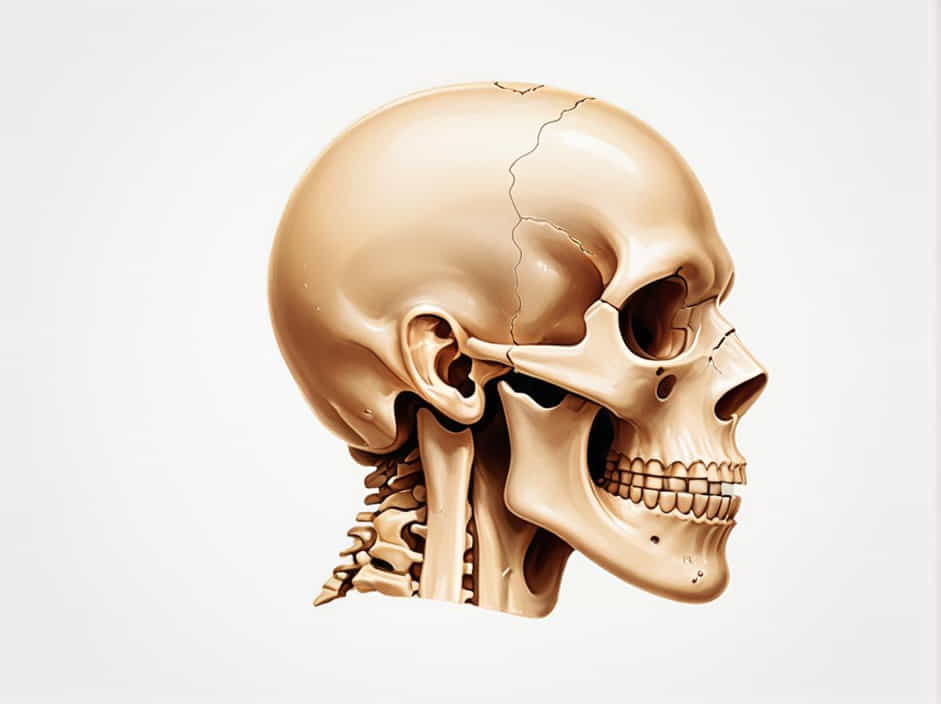The human skull is composed of multiple bones that connect to form a strong yet flexible structure. One of the key connections in the skull is the juncture of the zygomatic bone and the temporal bone. This junction plays a crucial role in facial structure, function, and biomechanics. It contributes to the zygomatic arch, which is important for facial aesthetics and muscle attachment.
we will explore the anatomy, function, clinical significance, and related conditions of the juncture of the zygomatic and temporal bones.
Anatomy of the Zygomatic Bone and Temporal Bone
Zygomatic Bone
The zygomatic bone, commonly known as the cheekbone, is a paired facial bone that provides the prominence of the cheeks. It is located on the lateral side of the face and forms parts of the orbit, temporal fossa, and infratemporal fossa.
Main Features of the Zygomatic Bone:
- Frontal process connects with the frontal bone.
- Maxillary process articulates with the maxilla.
- Temporal process joins with the temporal bone to form the zygomatic arch.
- Orbital surface contributes to the eye socket structure.
Temporal Bone
The temporal bone is a large, complex bone located on the side of the skull, near the ears. It plays a crucial role in protecting the brain and housing structures of the inner ear.
Main Features of the Temporal Bone:
- Squamous part forms the lateral wall of the skull.
- Petrous part contains the structures of the inner ear.
- Mastoid process serves as an attachment for neck muscles.
- Zygomatic process extends forward to meet the temporal process of the zygomatic bone.
Junction of the Zygomatic Bone and Temporal Bone
The connection between the zygomatic bone and temporal bone is known as the zygomatic arch. This arch is formed by the articulation of the temporal process of the zygomatic bone and the zygomatic process of the temporal bone.
Structure of the Zygomatic Arch
The zygomatic arch is a bony bridge located on the lateral side of the skull. It serves multiple functions, including:
- Providing structural support to the face.
- Serving as an attachment point for muscles involved in chewing (mastication).
- Protecting deeper structures, such as nerves and blood vessels.
The junction of these two bones is a fibrous joint, meaning it is a strong and stable connection.
Function of the Zygomatic Arch
1. Facial Structure and Aesthetics
The zygomatic arch contributes to the overall shape of the face. It plays a role in defining the cheekbones and is often considered a key feature of facial symmetry and attractiveness.
2. Muscle Attachment
Several muscles attach to the zygomatic arch, including:
- Masseter muscle one of the strongest muscles in the body, responsible for chewing.
- Temporalis muscle assists in jaw movement and elevation.
These muscles are essential for biting, chewing, and speaking.
3. Protection of Structures
The zygomatic arch acts as a protective shield for important structures, such as:
- The temporalis muscle, which passes underneath the arch.
- Nerves and blood vessels that supply the face.
Clinical Significance of the Zygomatic-Temporal Junction
1. Fractures and Trauma
The zygomatic arch is vulnerable to fractures, especially in sports injuries, car accidents, or physical altercations. Symptoms of a fracture include:
- Swelling and bruising around the cheek.
- Difficulty opening the mouth due to masseter muscle involvement.
- Flattening of the cheekbone, affecting facial symmetry.
Treatment often involves surgical realignment to restore facial structure and function.
2. Temporomandibular Joint (TMJ) Disorders
Although the TMJ is separate from the zygomatic arch, its proximity makes dysfunctions in the area interconnected. TMJ disorders may cause:
- Jaw pain
- Clicking or popping sounds when chewing
- Limited range of motion in the jaw
TMJ issues are often treated with physical therapy, bite guards, or surgery in severe cases.
3. Zygomatic Arch Deformities
Some individuals may have congenital or developmental deformities affecting the zygomatic arch. Conditions such as craniofacial syndromes or genetic disorders can alter the shape and function of this bony structure.
4. Cosmetic and Reconstructive Surgery
The zygomatic arch is a common site for cosmetic surgery. Many people seek cheek implants or bone contouring procedures to enhance facial aesthetics. Reconstructive surgery is also performed after fractures or congenital defects.
Comparison with Other Skull Junctions
The juncture of the zygomatic bone and temporal bone is unique in several ways:
| Feature | Zygomatic-Temporal Junction | Other Skull Junctions (e.g., Frontal-Sphenoid) |
|---|---|---|
| Function | Facial structure, muscle attachment | Brain protection, cranial stability |
| Mobility | Fixed and strong | Some allow minor movement (e.g., sutures) |
| Muscle Involvement | Masseter, Temporalis | Various depending on location |
| Clinical Issues | Fractures, TMJ disorders | Skull fractures, craniosynostosis |
The juncture of the zygomatic bone and temporal bone forms the zygomatic arch, which is a critical component of facial anatomy. It provides structural support, muscle attachment, and protection for deeper structures in the face.
Understanding this anatomical connection helps in diagnosing fractures, TMJ disorders, and facial deformities. Whether in cosmetic surgery or trauma recovery, the zygomatic arch remains a significant feature in both medicine and aesthetics.
For those studying human anatomy, the zygomatic-temporal junction is an essential area to understand, as it plays a vital role in function and appearance.
